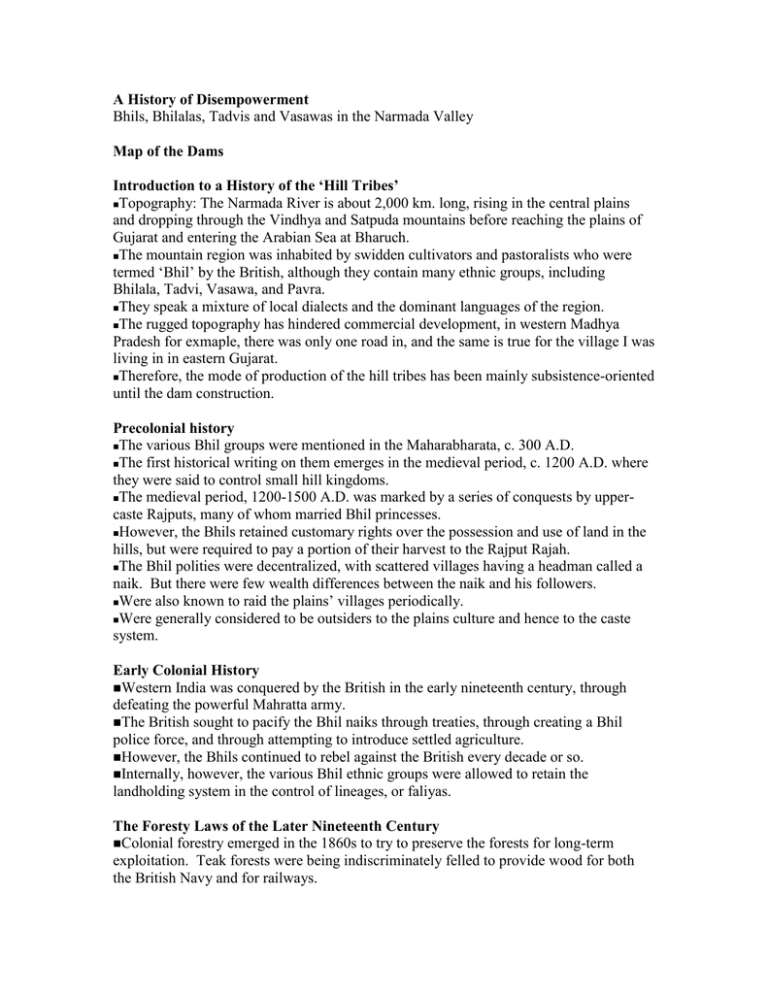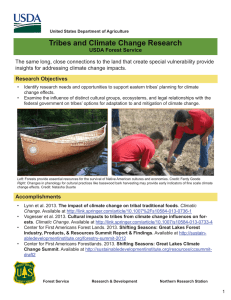A History of Disempowerment Map of the Dams
advertisement

A History of Disempowerment Bhils, Bhilalas, Tadvis and Vasawas in the Narmada Valley Map of the Dams Introduction to a History of the ‘Hill Tribes’ Topography: The Narmada River is about 2,000 km. long, rising in the central plains and dropping through the Vindhya and Satpuda mountains before reaching the plains of Gujarat and entering the Arabian Sea at Bharuch. The mountain region was inhabited by swidden cultivators and pastoralists who were termed ‘Bhil’ by the British, although they contain many ethnic groups, including Bhilala, Tadvi, Vasawa, and Pavra. They speak a mixture of local dialects and the dominant languages of the region. The rugged topography has hindered commercial development, in western Madhya Pradesh for exmaple, there was only one road in, and the same is true for the village I was living in in eastern Gujarat. Therefore, the mode of production of the hill tribes has been mainly subsistence-oriented until the dam construction. Precolonial history The various Bhil groups were mentioned in the Maharabharata, c. 300 A.D. The first historical writing on them emerges in the medieval period, c. 1200 A.D. where they were said to control small hill kingdoms. The medieval period, 1200-1500 A.D. was marked by a series of conquests by uppercaste Rajputs, many of whom married Bhil princesses. However, the Bhils retained customary rights over the possession and use of land in the hills, but were required to pay a portion of their harvest to the Rajput Rajah. The Bhil polities were decentralized, with scattered villages having a headman called a naik. But there were few wealth differences between the naik and his followers. Were also known to raid the plains’ villages periodically. Were generally considered to be outsiders to the plains culture and hence to the caste system. Early Colonial History Western India was conquered by the British in the early nineteenth century, through defeating the powerful Mahratta army. The British sought to pacify the Bhil naiks through treaties, through creating a Bhil police force, and through attempting to introduce settled agriculture. However, the Bhils continued to rebel against the British every decade or so. Internally, however, the various Bhil ethnic groups were allowed to retain the landholding system in the control of lineages, or faliyas. The Foresty Laws of the Later Nineteenth Century Colonial forestry emerged in the 1860s to try to preserve the forests for long-term exploitation. Teak forests were being indiscriminately felled to provide wood for both the British Navy and for railways. Enacted a series of severe laws that created a new regime of power/knoweldge: Based on the appropriation of all the forested areas of India by the Forestry Department. Also created minute, daily regulations governing the access to an use of forest products. Accumulation of Forest Areas Forestry officials were most concerned with slash and burn cultivation, which they saw as ‘primitive, and destructive of valuable commodities, such as teak. 1865 and 1871 Forest Laws (amended in 1929 and continued to the present day): Creation of reserved and protected forests: No cultivation or human access was allowed in reserved forests. Some human habitation and cultivation allowed in protected forests, but under the supervision of the Forestry Department. The Acts decreed that the rights of existing inhabitants of the forests should be recognized, BUT they required that such rights had to be supported by written proof of ownership with a previous ruler and were to be presented within 3 months of the date of notification of a R or P forest. Appointed Forest Officers with the powers to declare areas reserved and to punish offences unilaterally. Criminalization of Forest Tribes The following activities were prohibited: ‘The construction of any fresh clearing, ...setting fire to a reserved forest, or kindling any fire in such manner as to endanger the same....except at such seasons as the ForestOfficer may from time to time notify in this behalf, trespassing of cattle, or permitting cattle trespass, causing... damage by negligence in felling any tree or cutting or dragging any timber, felling, girdling, lopping, tapping, or burning of any tree, stripping-off the bark or leaves from, or otherwise damaging any tree... quarrying any stone, burning lime or charcoal, or collecting, subjecting to any manufacturing process or removing any forest-produce, clearing any land for cultivation or any other purpose; or, killing elephants, hunting, shooting, fishing or setting traps or snares...’[i] [i] OIOC, V/8/49/1878. Involved the criminalization of many everyday activities necessary for slash and burn cultivation. Also created the category of ‘Criminal Tribes’ in 1871: these were groups whose lifestyle was thought to produce ‘hereditary criminals’ and some of the Bhil tribes were thought to be hereditary theives and raiders. Also created forest villages, where Bhils were moved to provide labour for the Forest Department. At the same time, there emerged a discourse about the ‘hardiness and suitability for manual labour’ of the hill tribes. Postcolonial Continuities When India became independent in 1947, it rescinded the Criminal Tribes Act, but allowed the Forest Acts to remain in all their essentials. Between 1951 and 1998, the Indian Forest Act (1927) was used to enlarge the holdings of reserved and protected forests from 41 million to 67 million hectares, i.e. 28% of India’s land surface. The Forest Conservation Act of 1980 and the Wildlife Protection Act of 1972 have further eroded the land base and allowable activities of tribal cultivators. Furthermore, the Land Acquisitions Act (1891) allows the state to appropriate any land and/or buildings if this is deemed to be in the national interest. However, the current government has promised to introduce the Scheduled Tribes Bill (2005) which will vest individual property rights for hill tribes residing in a region prior to 1980. But it does not apply to those whose lands have already been appropriated, e.g. those in the Sardar Sarovar command area. It also does not include those who are not already registered as Scheduled Tribes, no matter how long they may have been residing in forest areas. At present, there are major debates on this bill occurring in India, with the strongest critics being the Forest Department and conservationists, who argue that ‘tribal management will lead to the ‘extinction of endangered species.’ Discourses and Hegemonies: the distinction between the ‘settled’ + ‘civilized’ versus the ‘nomadic’ and ‘uncivilized’. In colonial and ‘international’ law, European expansion witnessed the forging of legal instruments which justified the conquest of lands already inhabited. John Locke: distinguished between a state of nature and a state of culture. State of nature= those societies that did not practise settled agriculture and did not have institutions of private property. Their use of the land was deemed mere ‘labour appropriation’ and was located closer to the ‘animal’ than the human realm. The concept of terra nullius, or ‘empty space’: Latin for the ‘land of no one’, terra nullius referred to that territory which was inhabited by peoples whose social or political organisation was not recognised as ‘civilized’ in international law until the ILO and UN passed their respective conventions on indigenous peoples in the late 1950s. Sovereignty over territory was established through effective occupation by a sovereign state. Because most lands had inhabitants, and the traditional legal doctrine hindered expansion, the term ‘terra nullius’ was extended in the 1700s to mean lands that were uncultivated according to European standards i.e., where the inhabitants had no fixed residences. Contemporary historical residues In the Indian, as well as North American contexts, these political and legal ideas guided policy makers and development planners until fairly recently. Most states today, for example, have Land Acquisition Acts and most, until very recently, have differentiated the property rights of settled versus nomadic populations: with the latter having few rights In India, the discourse around ‘criminal tribes’ and their rehabilitation applied only to populations who were nomadic or semi-nomadic. Development planners and policy makers still tend to view lands inhabited by ‘tribal’ populations as ‘terra nullius.’


